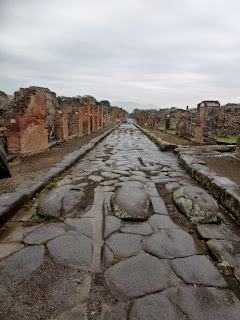Before the holidays I went and bought "Dominion" by C.J.Sansom. It said in the reviews at the front that readers who had enjoyed "Fatherland" by Robert Harris, would love this book. Being slightly OCD, I decided that I would have to read the Robert Harris novel first because it was written first. Amazon offered me ALL the Robert Harris novels for a few pounds and I had a happy time filling part of the new landing shelves with the Robert Harris novels I needed to complete the set.
So we went on holiday and while I was reading "Fatherland", DJ read "Dominion". I finished first. It has less pages and density in the reading.
The hotel in Italy had a deposit of read-and-left paperbacks and so I selected "Alone in Berlin" by Hans Fallada. I'm glad I did. It will always be remembered by me. The reading of it was steady and rewarding. The characters didn't have to explain themselves.
I'm now reading "Dominion" and am about a third of the way through. Without doubt and out of the three shown here, "Alone in Berlin" will live on in my mind. The others will join the BULIMIC READING described by Carol eventually and the Robert Harris collection will be avidly read and just as rapidly blurred into a forgotten library.
Last weekend I attended the funeral of Bernard Griffin who was Principal Architect for Middlesbrough Council. He was a very talented architect and Middlesbrough has benefitted from his foresight and social awareness. His latest project was The Custom's House but there are many public and community buildings which have had his touch over the years. He went to College in London with my sister and the course was six years long which is one of the reasons why our family all knew and loved Bernard and why he will live on in our memories.
And just to show how much he is growing...Billy is asking where his breakfast is. The answer is easy...same place as elevenses, lunch, arvo tea, dinner and supper. Placed in a bowl and then very rapidly devoured.
He is a delightful kitten.
Cheers
Gillian
So we went on holiday and while I was reading "Fatherland", DJ read "Dominion". I finished first. It has less pages and density in the reading.
The hotel in Italy had a deposit of read-and-left paperbacks and so I selected "Alone in Berlin" by Hans Fallada. I'm glad I did. It will always be remembered by me. The reading of it was steady and rewarding. The characters didn't have to explain themselves.
I'm now reading "Dominion" and am about a third of the way through. Without doubt and out of the three shown here, "Alone in Berlin" will live on in my mind. The others will join the BULIMIC READING described by Carol eventually and the Robert Harris collection will be avidly read and just as rapidly blurred into a forgotten library.
Last weekend I attended the funeral of Bernard Griffin who was Principal Architect for Middlesbrough Council. He was a very talented architect and Middlesbrough has benefitted from his foresight and social awareness. His latest project was The Custom's House but there are many public and community buildings which have had his touch over the years. He went to College in London with my sister and the course was six years long which is one of the reasons why our family all knew and loved Bernard and why he will live on in our memories.
And just to show how much he is growing...Billy is asking where his breakfast is. The answer is easy...same place as elevenses, lunch, arvo tea, dinner and supper. Placed in a bowl and then very rapidly devoured.
He is a delightful kitten.
Cheers
Gillian



































